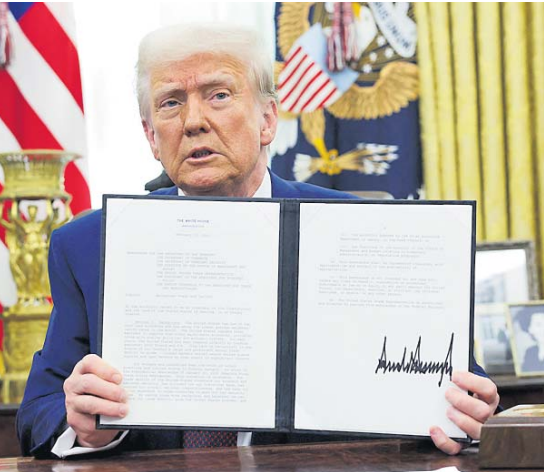On February 10, 2025, US President Donald Trump announced a sweeping change in trade policy — a 25 per cent tariff on all imported steel and aluminium, effective March 4, 2025. Unlike previous measures, this new tariff applies to every country, with no exceptions even for longtime allies. While much of the world’s attention has been on major economies like the United States and Europe, smaller nations such as Fiji are also set to feel the impact. Here’s a look at what these tariffs mean for Fiji, explained in simple terms for everyone to understand
What does Trump’s tariff mean?
Mr Trump’s decision to impose a 25 per cent tariff on steel and aluminium is meant to encourage US companies to use American-made products rather than relying on imported metals. The idea is that by making foreign steel and aluminium more expensive, US manufacturers will buy more domestically produced materials. However, when one of the largest economies changes its trade rules, the effects ripple out worldwide.
For countries that export these metals, this tariff leads to higher prices to cover the extra cost. And because global markets are closely linked, those price increases are not confined to the US, they spread to all buyers including small island nations like Fiji.
Direct impact on Fiji
Fiji, a small island nation in the South Pacific, depends heavily on imported materials for building its infrastructure. Roads, bridges, schools, and hospitals are often constructed with steel and aluminium. With the new tariff, the price of these vital materials is expected to rise.
This means:
Higher import costs: Fiji will likely pay more for each shipment of steel and aluminium. Exporters may raise their prices to maintain profits, and these increased costs will be passed on to Fiji.
More expensive construction projects: Local builders and government agencies that rely on these materials will face higher costs. This could delay new projects or force cuts in spending elsewhere.
Budget strains: As costs rise, Fiji’s government may find it harder to finance necessary public works. This could slow down improvements in infrastructure that are key to economic development.
Indirect effects on Fiji’s economy
The impact of the tariff goes beyond just the cost of metal. Here are some broader ways it could affect Fiji:
Rising prices for consumers
When building materials become more expensive, the cost of constructing homes, offices, and public facilities increases. This can lead to higher rent or mortgage payments, increased prices for goods, and overall inflation in the local economy. In Fiji, where many people already face financial challenges, even a small rise in prices can be significant.
Supply chain disruptions
Global supply chains are very connected. If exporters change their usual routes to deal with higher US prices or shift their focus to markets with fewer restrictions, Fiji might experience delays or shortages in receiving the materials it needs. Finding new suppliers on short notice can be difficult and may result in further price increases.
Impact on foreign investment
Fiji’s economy benefits from investments in infrastructure and tourism. However, rising costs and uncertainty over the price of essential materials could make potential investors more cautious. When construction and manufacturing costs are unpredictable, businesses may delay or cancel planned projects, slowing down economic growth.
Increased cost for everyday goods
Many local products and services rely on steel and aluminium. Whether it’s public transportation or consumer goods made in factories, the higher cost of raw materials can lead to increased prices across the board. This chain reaction could reduce the purchasing power of ordinary Fijians, affecting daily life.
What can Fiji do?
Even though Fiji is facing challenges from global trade policies, there are steps it can take to lessen the impact:
Diversify import sources:
Instead of relying on just one or two suppliers for steel and aluminium, Fiji can look for alternative sources. By spreading out its supply chain, the country might secure more competitive prices and reduce the risk of shortages.
Explore alternative materials:
While steel and aluminium are common, there are other building materials and construction techniques that might be more affordable. Investing in research and development for alternative materials could open up new options for local construction projects.
Strengthen regional ties:
Fiji can also work more closely with nearby countries to form stronger trade agreements. By negotiating as part of a regional bloc, Fiji and its neighbors might secure better terms and reduce the risk of sudden price hikes from external policies.
Support local industries:
In the long run, Fiji could consider ways to boost local production of building materials. Even if it does not become a major steel or aluminium producer, supporting local industries can help stabilize the market and create jobs.
Looking ahead
The new 25 per cent tariff on steel and aluminium is a clear sign that global trade is changing. While President Trump’s policy is designed to protect American jobs, its effects are felt far beyond US borders. For Fiji, this policy means higher costs for construction materials, potential delays in infrastructure projects, and a greater burden on the economy.
Fiji’s future will depend on how well it can adapt to these changes. By diversifying import sources, exploring alternative building methods, and strengthening regional economic ties, Fiji has a chance to minimise the negative impacts. The coming months will be critical as local leaders and businesses work to secure a stable and affordable supply of essential materials.
In conclusion, while Mr Trump’s tariff may be intended to boost the US economy, its global effects could slow down progress in countries like Fiji. With careful planning and smart policy decisions, however, Fiji can navigate these turbulent times and continue on a path toward growth and prosperity.



